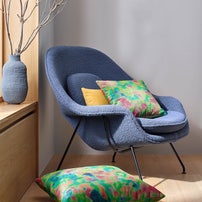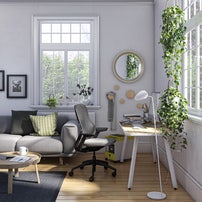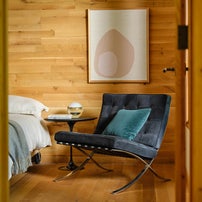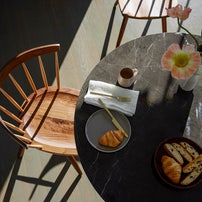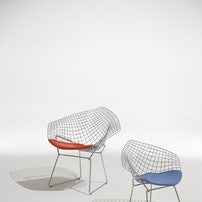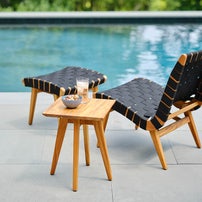Knoll Franco Albini Desk
Franco Albini’s 1928 desk combines glass, steel and wood with striking clarity and balance. A clear demonstration of Albini’s rationalist design philosophy and minimalist aesthetic, the design derives its appeal through simplicity of form and celebration of material, without extraneous ornamentation.
MEASUREMENTS:
- Height: 69.8 cm / 27.5 inch
- Width: 121.9 cm / 48 inch
- Depth: 66 cm / 26 inch
MATERIALS:
- Frame and legs are square steel tube with polished chrome finish
- Top is ½” clear tempered glass
HELPFUL NOTES:
- Frame/Drawers available in two finish options
- Drawer mounts only on right side
- Pedestal drawer is either ebonized oak or white lacquer and mounts to the right side of desk
- Greenguard Indoor Air Quality Certified®

Franco Albini
Italy, 1905 - 1977
Franco Albini studied architecture at the Milan Polytechnic school, where he obtained his diploma in 1929. Still being a student, Albini assisted Gio Ponti in his studio. Ponti's influence becomes obvious in Franco Albini's early designs in the Art déco style.
In 1930 Franco Albini opened his own studio for interiour design and decoration. After the war, Franco Albini worked as an architect, too. In 1930 Franco Albini participated in the Monza Triennale where he showed his furniture designs. At the 1936 Milan Triennale, Franco Albini presented progressive designs for a rational layout for small rooms, called "stanza per un uomo" (one-man room).
Albini designed a tiny room, in which each element fulfilled one or more functions: a tabletop is integrated in a shelving system, the ladder leading up to the loft bed also functions as a clothes stand, and the bed itself is a partition for the room. In 1941 Franco Albini designed a transparent radio (however, it was never produced).
Franco Albini's most popular designs were done in the 1950s. The most famous ones were his designs for shelves and chairs, produced by Cassina and especially by Poggi. The shelves are easy to disassemble and can be expanded without restriction. The shelves have no back board as they are either clamped between the floor and the ceiling or suspended on the ceiling on metal chains. This construction then functions as a transparent room partition. In 1951 Franco Albini created his rattan chair "Margherita".
From 1952 the designer and architect Franca Helg was Franco Albini's business partner; she played a crucial role in numerous Albini designs. As an architect, Franco Albini built housing estates in Milan and in 1957, he designed the building for the La Rinascente department store in Rome. Together with Franca Helg and Bob Noorda, Franco Albini also designed underground stations in Milan. From 1963 to 1977 Franco Albini taught at the Polytechnic school in Milan. He died in 1977.

Knoll has lived their guiding principle, "good design is good business," since 1938. Products are all created to inspire, fit, and last. The Bauhaus philosophy that furniture should complement, not compete with architecture, is central to Knoll’s design. Its extensive portfolio includes office work systems, residential mid-century modern classics, textiles, and accessories.
Designers like Harry Bertoia, Eero Saarinen, Warren Platner, Isamu Noguchi, and Florence Knoll contributed to Knoll’s iconic designs. Knoll invests in research and field studies and explores organizational behavior and technology to ensure quality excellence. As a leader in sustainability, Knoll’s practices reduce waste and conserve resources. Based in Pennsylvania, Knoll has a strong international presence, and 40 products are in the permanent collection of the Museum of Modern Art in New York.
Knoll products incur a 7.5% shipping charge at checkout, with a minimum of $85 and maximum of $500. This fee reflects White Glove Delivery for large items, which includes bringing the item to your room of choice, unpacking, removal of packaging, and assembly.
For further information on our shipping policies click here.
For further information on returns + refunds click here.


